One of the core principles of Edgar Cayce’s dietary advice is eating a variety of foods to establish a balance between acids and alkalines. Dense proteins containing sulfur or phosphorus are acidic, whether they come from animal or plant sources. Dietary sources of Alkaline minerals are foods that have plenty of Calcium, Magnesium, and Potassium. The fourth alkaline mineral which we need in quantity is Sodium, which can be obtained through salt or baking soda, in addition to the amount contained in foods.
I’ve been trying to grow vegetables for many summers now. Every summer I’ve spent vastly more on my garden than I’ve harvested as food, but I think this is the summer I’ll break even.
To summarize this post in a nutshell: if you don’t know much about gardening, dandelion greens are the cheapest, most robust vegetable you can grow. They are forgiving, and come back by themselves year after year. I think dandelions would grow inside, if you don’t have an outside space. Dandelion greens should be well cooked. If you need seeds, sign up for my free reports email list, respond to the email with your address and I’ll send you some.
Green vegetables are a good source of magnesium and calcium. Cayce said some of these could be eaten raw (lettuce, celery), while other vegetables are best consumed after they’re cooked in their own juices. This means cooking with Patapar paper or another cooking method that doesn’t dilute the vegetable juices with water. Cooking makes vegetables more edible by deactivating the anti-nutrients which plants use to defend against their consumption. Root vegetables (potatoes), fruits (juices) and dairy products are good sources of potassium.
I’ve decided the easiest plants to grow myself are the ones that grow back from the roots every summer: rhubarb, dandelions, sunchokes, chard, strawberries,etc… Rhubarb was referred to as pie plant in the readings, and has an especially valuable type of fiber.
This summer I’m going to concentrate my gardening efforts on the following plants:
- Dandelions – These grow back, and are robust. Good source of magnesium and many other nutrients. (Dandelions do get bitter, and some people can’t stomach bitter foods… just found a page with tips for using dandelions.)
- rhubarb – grows back every summer, and is not eaten by gophers. I just figured out I could pull out the flower stalks and get them to root. See picture below.
- Sunchokes (jerusalem artichokes) – The root tubers of this plant are a good source of the prebiotic fiber inulin, which helps feed friendly intestinal bacteria. Will spread everywhere, if you live where water falls from the sky.
- Sweet potatoes are not as robust as regular potatoes, but they’re more expensive at the stores than regular potatoes, so I’m going to try them out.
- Passionflower – harvest the flowers, dry for tea. Going into Earthbox #1. I will bring inside for the winter.
- Passionfruit – Going into Earthbox #2.
- Okra – saved a lot of seeds
- Basil – saved a lot of seeds
- Safflower – going to buy some seeds. The petals of this flower were recommended by Cayce as an herbal tea to coat the stomach. It’s relatively rare at the herb stores I’ve visited, and was sort of expensive when I did find it.
Growing on a rocky hillside
Plants need a place to spread their roots. The space I have is a rocky hillside with gophers and rabbits.
Four summers ago I bought a few bales of straw, for straw bale gardening. I had a nice tomato plant going, then the plant disappeared. The tunnel suggested gophers ate my tomato plant, but I never caught the perpetrator. I bought wire mesh to put underneath the straw bales, which stopped the plants from disappearing. I got about three summers out of those straw bales, and have been using the decomposed straw as a soil amendment in my raised beds.
I recently learned that straw bales can attract rodents. If you live in a city without predators to keep mice under control, straw bales might not be a good growing medium for you.
I’m also using raised beds. My raised beds have wire mesh underneath to keep gophers out, and chicken wire around the tops to keep rabbits out. I bought the lumber from the clearance racks at various lumber yards, which substantially reduced the cost. Because commercial wood stains usually have heavy metals, I’ve used plain vegetable oil, as drying oil, to hopefully get my beds to last longer.
One of the pictures below shows a white plastic growing container. This is an earthbox container gardening system. A water reservoir in the base that helps keep the plants watered. Earthboxes are vastly more expensive now than when I bought mine, maybe 15 years ago. The earthbox patent expired; generic earthboxes are now available. I found the brown generic earthbox at a yard sale for a few dollars last fall. One problem with the earthbox is that most the nutrients for plant growth have to be added as fertilizers. They work especially well for growing tomatoes.
(tap/click on these pictures for the enlarged version)
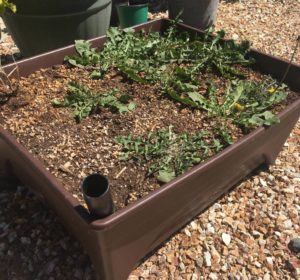
Dandelions are robust, and grow back every spring. 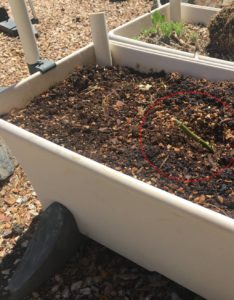
Passionfruit vine, started from seed, eaten by something, slowly coming back from the base 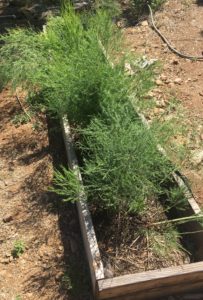
Asparagus tips were not recommended by Cayce 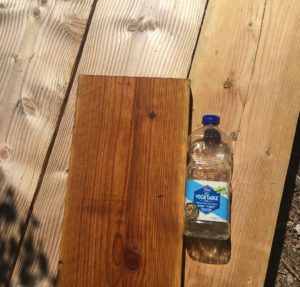
vegetable oil is a cheap stain to hopefully help preserve wood 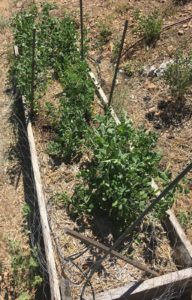
Peas planted in raised bed, filled with compost and straw 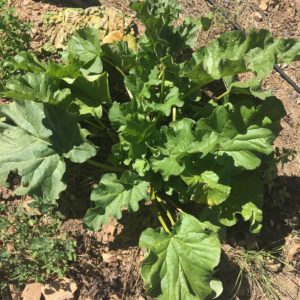
rhubarb is not eaten by gophers 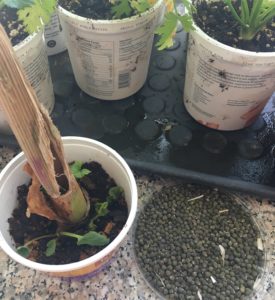
rhubarb flower stalks are rooting out. Also: okra seeds and celery 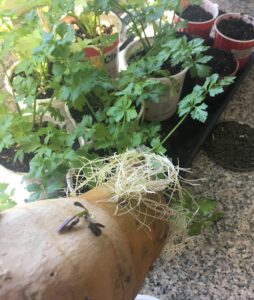
sweet potato starts. consulted with Youtube 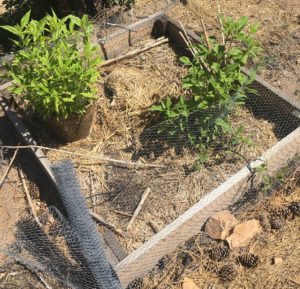
jerusalem artichokes are robust, and come back year after year.